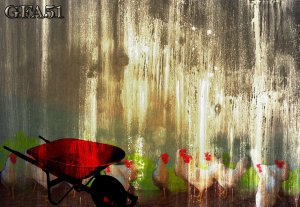William Carlos Williams’ poem “The Red Wheelbarrow” is definitely a poem that broke the mold of the traditional romantic poems of the time. As a member of the imagist movement, that emphasized on visual images and clear and precise language, Williams set the stage for future poets to break with tradition and embrace innovation. With the use of formal elements such as sentence structure, and the varied use of connotative word meanings Williams fulfills his purpose of creating a unique and intricate poem.
Williams’ sentence structure at first might be viewed by the reader as confusing but, truly this contributes to the real impact of this poem which is the unique external form of separating parts of the sentence into stanzas. A simple sentence for example, “so much depends/ upon” is separated from one line to the next also known as enjambment. Again to some it might seem pointless but the true purpose of this technique is to allow the reader to contemplate ideas in the poem that perhaps without enjambment would not be considered like “so much depends on what?” or “what exactly does the wheelbarrow represent here?”. Another factor contributing to the impact of this precise poem is the use of very definite diction. Every word is carefully chosen to provide a clear image for the reader; no word is left without a strong meaning as each one contributes to the lasting visual impression of the poem. For example his use of the word “glaze” in the third stanza, line 5 derives both a strong denotation and connotation. The denotations derived from glaze include: to make to shine like glass, and to gloss over. This in turn creates a radiant image of a simple red wheelbarrow that when “glazed with rain/ water” is elevated to something more than a mere object but rather a piece of fine art. The same word through its connotation derives its connection to pottery. In pottery to glaze an object is to cover the object in a clear or colored liquid that when heated properly produces a more aesthetically pleasing art piece. The same here can be said about the wheelbarrow. At first merely, an inattentive object, when “glazed with rain/water” becomes something more than an object, more importantly the central focus of the poetic art masterpiece that is the “The Red Wheelbarrow”. William Carlos Williams’ treatment of this common object in his poem elevates it to something aesthetically innovative. He paints a picture, a visual image that the reader can distinguish as the poem progresses. The Red wheelbarrow glazed surface is brought out even more by being placed “beside the white/ chickens” creating a contrast of colors which no longer represents a mere poem but a painting carefully constructed by each sentence, like an artist carefully focusing his attention on each word, and sentence, Williams transforms poetry into art.
Visual aids that can be found on the internet, for example pictures, provide for a more in depth look at what Williams was trying to portray. One thing is visualizing a red wheelbarrow in your mind but actually seeing it through pictures provides the reader with the image Williams was trying to illustrate. He painted this picture through words but to see it in an actual picture gives Williams’ techniques a real element of appreciation.
Word Count: 551

Leave a comment